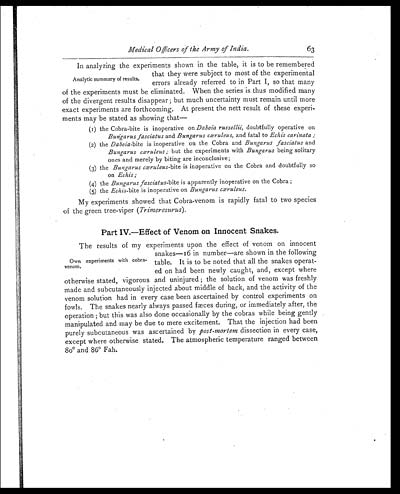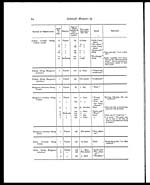Medicine - Institutions > Army health reports and medical documents > Scientific memoirs by medical officers of the Army of India > Part IV, 1889 > 4 - Are venomous snakes auto-toxic?-an inquiry into the effect of serpent-venom upon the serpents themselves
(83) Page 63
Download files
Individual page:
Thumbnail gallery: Grid view | List view

Medical Officers of the Army of India.
63
Analytic summary of results.
In analyzing the experiments shown in the table, it is to be remembered
that they were subject to most of the experimental
errors already referred to in Part I, so that many
of the experiments must be eliminated. When the series is thus modified many
of the divergent results disappear; but much uncertainty must remain until more
exact experiments are forthcoming. At present the nett result of these experi-
ments may be stated as showing that—
(1) the Cobra-bite is inoperative on Daboia russellii, doubtfully operative on
Bungarus fasciatus and Bungarus cæruleus, and fatal to Echis carinata;
(2) the Daboia -bite is inoperative on the Cobra and Bungarus fasciatus and
Bungarus cæruleus; but the experiments with Bungarus being solitary
ones and merely by biting are inconclusive;
(3) the Bungarus cæruleus -bite is inoperative on the Cobra and doubtfully so
on Echis;
(4) the Bungarus fasciatus -bite is apparently inoperative on the Cobra;
(5) the Echis -bite is inoperative on Bungarus cæruleus.
My experiments showed that Cobra-venom is rapidly fatal to two species
of the green tree-viper (Trimeresurus ).
Part IV.—Effect of Venom on Innocent Snakes.
Own experiments with cobra-
venom.
The results of my experiments upon the effect of venom on innocent
snakes—16 in number—are shown in the following
table. It is to be noted that all the snakes operat-
ed on had been newly caught, and, except where
otherwise stated, vigorous and uninjured; the solution of venom was freshly
made and subcutaneously injected about middle of back, and the activity of the
venom solution had in every case been ascertained by control experiments on
fowls. The snakes nearly always passed fæces during, or immediately after, the
operation; but this was also done occasionally by the cobras while being gently
manipulated and may be due to mere excitement. That the injection had been
purely subcutaneous was ascertained by post-mortem dissection in every case,
except where otherwise stated. The atmospheric temperature ranged between
80° and 86° Fah.
Set display mode to: Large image | Zoom image | Transcription
Images and transcriptions on this page, including medium image downloads, may be used under the Creative Commons Attribution 4.0 International Licence unless otherwise stated. ![]()
| Permanent URL | https://digital.nls.uk/75000132 |
|---|
| Shelfmark | IP/QB.10 |
|---|---|
| Additional NLS resources: | |




